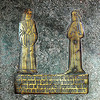16th century church monuments
In the 16th century (c. 1500–1600), church monuments transitioned from late Gothic to Renaissance styles amid the Reformation (1530s onward). Brasses dominated for the middle classes; alabaster tombs for elites. Meanwhile religious upheaval reduced overt Catholic imagery.
The monuments of this century were transitional, Gothic brasses and alabaster knights gave way to Renaissance tablets and Protestant restraint, reflecting faith, fashion, and Reformation upheaval.
This period represents the golden age and swan song of memorial brasses in England. These engraved brass plates, set flush into church floors or walls, reached their peak in size, artistry, and social reach before declining sharply after 1600. They are quintessential documents of Tudor society, Reformation theology, and commercial craftsmanship.
This was the final flourish of alabaster effigial sculpture in England. Once the premier medium for noble and gentry tombs (14th–15th c.), alabaster faced Reformation disruption, iconoclasm, and Renaissance competition, yet still produced some of the most refined, emotionally expressive figures in English funerary art.
Brass
William Thorpe (d1504) and wife. St. Mary, Higham Ferrers, Northamptonshire.
Thomas Knightley (1516). St Mary, Fawsley, Northamptonshire.
Thomas Andrewes (d1541). Holy Trinity, Charwelton, Northamptonshire.
Full length figure brass of Sir Richard Catesby 1553. Ashby St. Ledgers, Northamptonshire.
Richard Pynfold (d1566) and wife. Dunstable Priory, Bedfordshire.
Brass monument to Thomas Wylmer (d1580). Staverton, Northamptonshire.
Tomb chests and Effigies
Children of France (c1506) - Tours Cathedral.
Don Garcia de Osorio (1499-1505) Toledo Spain.
Donna Maria de Perea (1499-1505) Toledo Spain.
Tomb of Arthur Tudor (d1502) and Chantry chapel - Worcester Cathedral.
Tomb of the cardinals of Amboise (1515-1525) - Rouen Cathedral.
Bishop Richard Mayew (d1516) - Hereford Cathedral.
Canon Adrien Hénencourt (d1530) - Amiens Cathedral.
Louis de Brézé (d1531) - Rouen Cathedral.
Catherine of Aragon (d1536). Peterborough Cathedral.
Tomb to Sir Richard Knightley and his wife Jane Skenard (c1540) St Mary, Fawsley, Northamptonshire.
Prior William Moore (c1545). Worcester Cathedral.
Francis Tanfield (d1558) and His Family. Gayton Northamptonshire
Thomas Cave (c1558). Stanford-on-Avon, Northamptonshire.
Tomb of Michelangelo Buonarroti (d1564) - Basilica of Santa Croce
Alexander Denton (d1576) and wife Anne (d1566). Hereford cathedral.
 Effigy of Sir Michael Poulteney (d1567). Alabaster tomb - St Leonard parish church. All Saints, Misterton, Leicestershire.
Effigy of Sir Michael Poulteney (d1567). Alabaster tomb - St Leonard parish church. All Saints, Misterton, Leicestershire.
Tomb of John Shirley (d1570) - Breedon-on-the-hill, Leicestershire.
Sir Robert Steward (d1570) monument - Ely Cathedral, Cambridgeshire
Tomb of Francis Shirley and wife (1571) - Breedon-on-the-hill, Leicestershire.
Effigies of Sir John Throckmorton (d1580) and his wife Marjorie. St. Peter, Coughton, Warwickshire.
Monument to Robert Dudley, Lord Denbigh (d1584) aged three - Warwick
Humfrey Peyto died 30 March 1585, and Anne his wife (1604). Chesterton, Warwickshire.
Abrose Dudley (d1590), 3rd Earl of Warwick. Warwick, Warwickshire.
Bishop Edmund Freke (d1591) - Worcester Cathedral.
 George Shirley and family tomb (1598) - Breedon-on-the-hill, Leicestershire.
George Shirley and family tomb (1598) - Breedon-on-the-hill, Leicestershire.
Henry Knollys and his wife Margaret Cave (c1600).
Wall monuments
Thomas Andrew family monument (1590).
Robert Price (d1595), Wife, and her parents - Churchover, Warwickshire.




















 Tomb of Sir Thomas Andrews (d1564) and his two wives, Katherine and Mary. Holy Trinity, Church Charwelton, Northamptonshire.
Tomb of Sir Thomas Andrews (d1564) and his two wives, Katherine and Mary. Holy Trinity, Church Charwelton, Northamptonshire.











